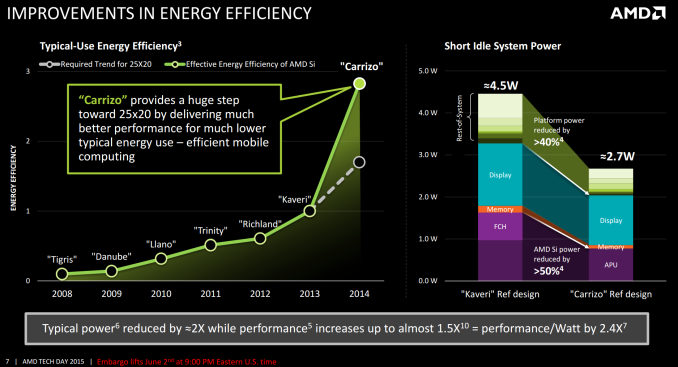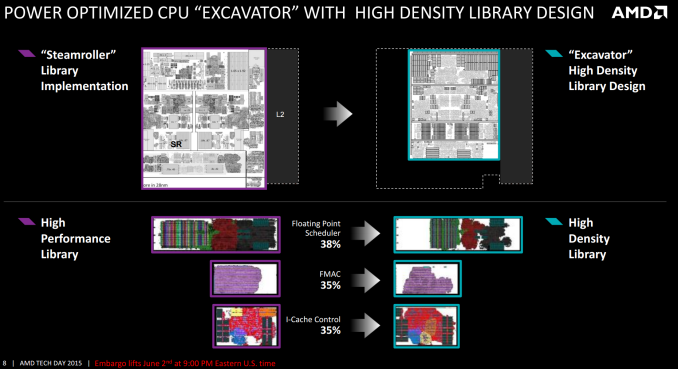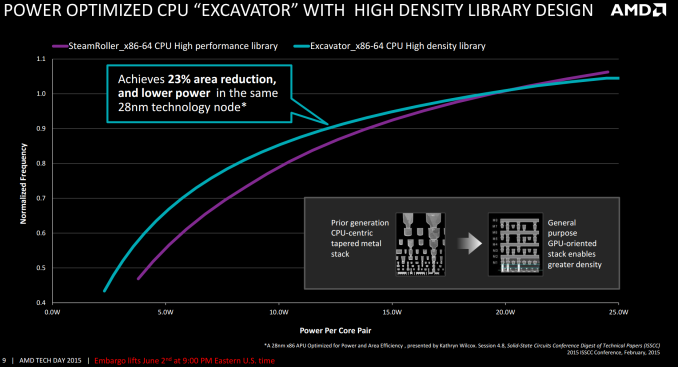AMD Launches Carrizo: The Laptop Leap of Efficiency and Architecture Updates
by Ian Cutress on June 2, 2015 9:00 PM ESTEfficiency and Die Area Savings
AMD’s take home message in all of this is efficiency. We a being quoted a performance per watt increase of 2.4x, coming from typical power draw savings of 2x and performance increase of almost 1.5x for 23% less die area, all in one go.
Ultimately this all helps AMD’s plan to be 25x more efficient with their APUs by 2020, and the cumulative bar chart on the right is how mobile improvements from all sides are being realized. Migrating the southbridge on die severely reduces its idle power consumption to almost zero and can help efficiencies elsewhere in the system. The APU general use and memory controllers are the next targets, but the common constant here is the display. Using a low power display might give battery life in exchange for quality, and there is only so much power you can save at the SoC level. In time, the display will be the main focus of power saving for these devices.
A big part of the reduction in die area comes from the set of high density libraries being used by AMD. Above were three examples provided where >33% gains were made in silicon area. Typically using a high density library design is a double edged sword – it reduces die area and potentially leaves more area for other things, but the caveat is that it may be more prone to defects in construction, require additional latency or have a different frequency/voltage profile. AMD assures us that these changes are at least like-for-like but most of them contain other improvements as well.
It’s worth noting here that AMD has described the high density library project internally as the equivalent of a moonshot, essentially the developers were part of a ‘skunkworks’ division attempting to make drastic changes in order to improve performance. The high density library is one such successful project from that.
With the new libraries, comparing Excavator to Steamroller shows the effect moving designs has. The power/frequency curve below 20W per module shifts to higher frequency/lower power, whereas losses are observed above 20W. However for 15W per module, this means either a 10%+ power reduction at the same frequency or a 5% increase in frequency for the same power. Should AMD release dual thread / single core APUs in the 7.5W region, this is where most of the gains are (as noted in the comments, the dual module designs are at 7.5W per module, meaning that what we should see in devices is already in the peak value for gains and benefits such as 25% frequency or 33% power). As also seen in the insert, the silicon stack has been adjusted to a more general purpose orientation. I could comment that this makes the CPU and GPU work better together, but I have no way of verifying this. AMD states the change in the silicon stack makes production slightly easier but also helps with achieving the higher density Excavator exhibits.













137 Comments
View All Comments
FlushedBubblyJock - Tuesday, June 9, 2015 - link
they probably have their contrast off, clear type disabled, the wrong screen font, smoothing edges of fonts disabled, then he's probably a far sighted coke bottled glasses with bifocals... thus amd must be had in dooper high rezz at 14fps...meacupla - Wednesday, June 3, 2015 - link
Ideally, what you'd get is a 2560x1440 screen with PROPER scaling to 1280x720, unlike what most monitors seem to do, which is a terrible job at scaling.SilthDraeth - Wednesday, June 3, 2015 - link
I run a Kaveri on my desktop and it drives 1080p just fine. Anyways, most intel laptops in that same range run 1366x768 screens also. At least almost every laptop you find in a Staples, or a Walmart. Very few of the devices on display have a higher resolution screen, or IPS solution.yankeeDDL - Wednesday, June 3, 2015 - link
Yes, *and* Intel's in that price range don't run games.FlushedBubblyJock - Tuesday, June 9, 2015 - link
yes they do make sure you have hd3000 at least but that's cheap as beansMargalus - Wednesday, June 3, 2015 - link
how is it an "issue that plagues AMD"? Are you saying AMD chips are buggy and crash at that resolution? Are you saying AMD graphics get corrupted at that resolution?medi03 - Thursday, June 4, 2015 - link
Ditto.In fact, 1366x768 TN (!!!) screen is the main issue with AMD mobile chips.
Drumsticks - Wednesday, June 3, 2015 - link
The 45W A8-6500T scores 71 in Cinebench R15. Even assuming that 15W kaveri gets identical performance (I couldn't think of a 15w kaveri chip to check on bench) that puts it at 106, which is finally, finally even with broad well in the xps 13, or at least <10%.Skylake will probably add another 10% gap, but this is the closest AMD might be in the last seven years or so to catching up with Intel. And at half the price, they could seriously have the start of a comeback!
xenol - Wednesday, June 3, 2015 - link
My only problem with AMD and the marketing blurbs is that they're targeting niche markets for all intents and purposes. Despite what PC gamers want us to think how big PC gaming is, it's not exactly a majority player in the entire scheme of things and gaming on a laptop isn't really that accepted.And even if gaming is involved, it's usually not games that require beefy specs to begin with.
Michael Bay - Wednesday, June 3, 2015 - link
PC gaming by marketshare is on par with any pastgen/nextgen console and sometimes more than one.